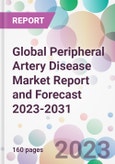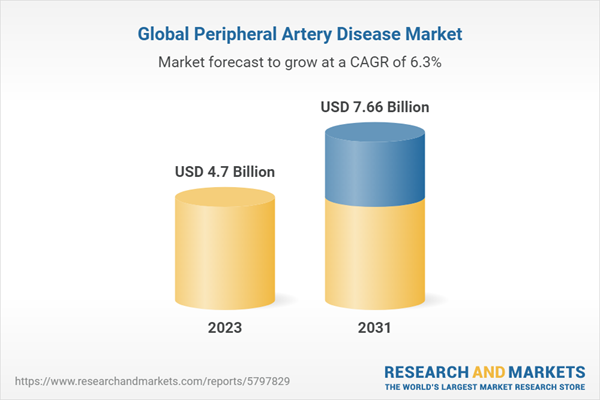The global peripheral artery disease market size attained a value of USD 4.42 billion in 2022. The market is anticipated to grow at a CAGR of 6.3% during the forecast period of 2023-2031 to attain a value of USD 7.66 billion by 2031.
PAD can have serious complications, as it increases the risk of coronary artery disease, heart attack, stroke, and mini-strokes or transient ischemic attacks. The reduced blood flow can also lead to tissue death (gangrene) in severe cases.
Early detection and management of PAD is crucial to reduce the risk of heart attack and stroke. It is typically managed with lifestyle changes, medications to prevent blood clots and lower blood pressure and cholesterol, and in some cases, surgical procedures to improve blood flow.
Peripheral Artery Disease Epidemiology
The epidemiology and market division of peripheral artery disease (PAD) are influenced by a variety of factors, including prevalence, age, gender, and lifestyle habits.
In terms of gender, while the market is likely more significant in men due to their slightly higher prevalence rates, the market for women is also substantial, especially in older age groups.
In terms of lifestyle habits, the market for PAD treatments is likely larger among smokers and individuals with unhealthy lifestyles, given their increased risk.
Overall, the PAD market is influenced by a variety of factors, with age, smoking, and unhealthy lifestyle habits being key drivers. As the global population ages and the prevalence of risk factors like smoking and obesity continues to rise, the market for PAD treatments is likely to grow
2. Cutting and Scoring Balloons
3. Drug-Coated Balloons
2. Balloon-Expandable
3. Covered Stents
4. Drug-Eluting Stents
2. Guiding Catheters
2. Retrievable Filters
2. Atherectomy Devices
2. Chronic Total Occlusion Devices
2. Introducer Sheaths
3. Guidewires
4. Balloon Inflation Devices
Peripheral Artery Disease Market: Introduction
Peripheral artery disease (PAD), also known as peripheral vascular disease (PVD), is a common circulatory problem in which narrowed arteries reduce blood flow to your limbs. The condition is caused by atherosclerosis, a build-up of fatty deposits (plaques) on the inner walls of the arteries. These deposits can reduce or block blood flow through the arteries, leading to PAD. While PAD can affect any arteries outside the heart, it most commonly affects the arteries in the legs.Risk factors for PAD include:
- Age: People over the age of 50 are at higher risk
- Smoking: Smoking contributes to constriction and damage of the arteries and is a significant risk factor for PAD and other diseases linked to atherosclerosis
- Diabetes: People with diabetes have a higher risk of developing PAD due to the increased likelihood of developing atherosclerosis
- High blood pressure and high cholesterol: These conditions contribute to the hardening and narrowing of arteries
- Obesity: Being overweight adds to the likelihood of developing PAD
- Family history: Individuals with a family history of PAD, heart disease, or stroke are at higher risk
PAD can have serious complications, as it increases the risk of coronary artery disease, heart attack, stroke, and mini-strokes or transient ischemic attacks. The reduced blood flow can also lead to tissue death (gangrene) in severe cases.
Early detection and management of PAD is crucial to reduce the risk of heart attack and stroke. It is typically managed with lifestyle changes, medications to prevent blood clots and lower blood pressure and cholesterol, and in some cases, surgical procedures to improve blood flow.
Peripheral Artery Disease Epidemiology
The epidemiology and market division of peripheral artery disease (PAD) are influenced by a variety of factors, including prevalence, age, gender, and lifestyle habits.
- Prevalence: PAD affects millions of people worldwide, with significant variations in prevalence among different regions. The disease is estimated to affect approximately 200 million people globally, with a higher prevalence in developed countries due to the aging population and high rates of diabetes and obesity
- Age: The risk of PAD increases with age. The prevalence of PAD is relatively low in individuals under 50 but begins to rise significantly in those over 60. By age 80, the prevalence can be as high as 20% or more
- Gender: Earlier in life, men are more likely than women to develop PAD, although the gap narrows with advancing age. By the age of 70, PAD prevalence rates in women approach those of men
- Lifestyle Habits: Certain lifestyle factors significantly influence the risk of developing PAD. Smoking is a strong risk factor, with smokers having up to four times the risk of PAD compared to non-smokers. Unhealthy diet, lack of exercise, and obesity also contribute to PAD risk
In terms of gender, while the market is likely more significant in men due to their slightly higher prevalence rates, the market for women is also substantial, especially in older age groups.
In terms of lifestyle habits, the market for PAD treatments is likely larger among smokers and individuals with unhealthy lifestyles, given their increased risk.
Overall, the PAD market is influenced by a variety of factors, with age, smoking, and unhealthy lifestyle habits being key drivers. As the global population ages and the prevalence of risk factors like smoking and obesity continues to rise, the market for PAD treatments is likely to grow
Peripheral Artery Disease Market Segmentations
The market can be categorised into type, treatment, distribution channel, end user, and region.Peripheral Artery Market Breakup by Type
- Peripheral Angioplasty Balloons
2. Cutting and Scoring Balloons
3. Drug-Coated Balloons
- Peripheral Stents
2. Balloon-Expandable
3. Covered Stents
4. Drug-Eluting Stents
- Peripheral Catheters
2. Guiding Catheters
- Inferior Vena Cava (IVC) Filters
2. Retrievable Filters
- Plaque Modification Devices
2. Atherectomy Devices
- Haemodynamic Flow Alteration Devices
2. Chronic Total Occlusion Devices
- Peripheral Accessories
2. Introducer Sheaths
3. Guidewires
4. Balloon Inflation Devices
Peripheral Artery Disease Market Breakup by Treatment
- Oral
- Parenteral
- Others
Market Breakup by Distribution channel
- Hospital Pharmacy
- Retail Pharmacy
- Others
Market Breakup by End user
- Hospitals
- Specialty Clinics
- Others
Peripheral Artery Disease Market Breakup by Region
North America
- United States of America
- Canada
Europe
- United Kingdom
- Germany
- France
- Italy
- Others
Asia Pacific
- China
- Japan
- India
- ASEAN
- Australia
- Others
Latin America
- Brazil
- Argentina
- Mexico
- Others
Middle East and Africa
- Saudi Arabia
- United Arab Emirates
- Nigeria
- South Africa
- Others
Peripheral Artery Disease Market Scenario
- The global market for peripheral artery disease (PAD) is expected to see robust growth in the coming years. This can be attributed to several factors, including an aging global population, increasing prevalence of lifestyle diseases like diabetes and obesity, and heightened awareness of PAD and its complications
- With PAD affecting a substantial number of people worldwide, there is a strong demand for effective treatments. The market comprises of various treatment options including medications, angioplasty and stenting, bypass surgery, and thrombolytic therapy. Among these, the angioplasty segment holds a significant market share due to its minimally invasive nature and high success rate
- Geographically, North America currently dominates the PAD market, owing to factors such as a high prevalence of PAD, advanced healthcare infrastructure, and high healthcare expenditure. However, the Asia-Pacific region is expected to witness the fastest growth rate during the forecast period. This can be attributed to factors such as a rapidly aging population, increasing incidence of diabetes and obesity, improving healthcare infrastructure, and growing awareness of PAD
- There is also a growing trend towards the development of innovative and more effective treatment options for PAD. Pharmaceutical and medical device companies are investing heavily in research and development activities to create novel therapies, with a number of these therapies currently in clinical trials. This innovation-driven growth is expected to contribute significantly to the expansion of the PAD market
- However, the PAD market faces certain challenges. These include the high cost of treatment procedures and lack of awareness about PAD in some regions, which may limit the diagnosis and treatment of the disease. Additionally, the risk of complications associated with treatment procedures may also restrain market growth
Key Players in the Global Peripheral Artery Disease Market
The report gives an in-depth analysis of the key players involved in the peripheral artery disease market, sponsors manufacturing the drugs, and putting them through trials to get FDA approvals. The companies included in the market are as follows:- AngioDynamics Inc
- B. Braun Melsungen AG
- Biotronik Inc
- Boston Scientific Corp
- Cook Group Incorporated
- Terumo Corporation
- Koninklijke Philips N.V
- Becton, Dickinson and Company
- W. L. Gore & Associates, Inc
- LeMaitre Vascular, Inc.
Table of Contents
1 Preface
3 Peripheral Artery Disease Overview
4 Patient Profile
5 Peripheral Artery Disease Epidemiology Analysis
6 Global Peripheral Artery Disease Market Overview
7 Global Peripheral Artery Disease Market Landscape
8 Peripheral Artery Disease Challenges and Unmet Needs
10 Global Peripheral Artery Disease Market Dynamics
11 Global Peripheral Artery Disease Market Segmentation
12 North America Peripheral Artery Disease Market
13 Europe Peripheral Artery Disease Market
14 Asia Pacific Peripheral Artery Disease Market
15 Latin America Peripheral Artery Disease Market
16 Middle East and Africa Peripheral Artery Disease Market
17 Regulatory Framework
18 Patent Analysis
19 Grants Analysis
20 Clinical Trials Analysis
21 Funding and Investment Analysis
22 Partnership and Collaborations Analysis
23 Supplier Landscape
24 Peripheral Artery Disease - Distribution Model (Additional Insight)
26 Company Competitiveness Analysis (Additional Insight)
27 Payment Methods (Additional Insight)
Companies Mentioned
- Angiodynamics Inc.
- B. Braun Melsungen AG
- Biotronik Inc.
- Boston Scientific Corp.
- Cook Group Incorporated
- Terumo Corporation
- Koninklijke Philips N.V.
- Becton, Dickinson and Company
- W. L. Gore & Associates, Inc.
- Lemaitre Vascular, Inc.
Methodology

LOADING...
Table Information
| Report Attribute | Details |
|---|---|
| No. of Pages | 160 |
| Published | May 2023 |
| Forecast Period | 2023 - 2031 |
| Estimated Market Value ( USD | $ 4.7 Billion |
| Forecasted Market Value ( USD | $ 7.66 Billion |
| Compound Annual Growth Rate | 6.3% |
| Regions Covered | Global |
| No. of Companies Mentioned | 10 |









